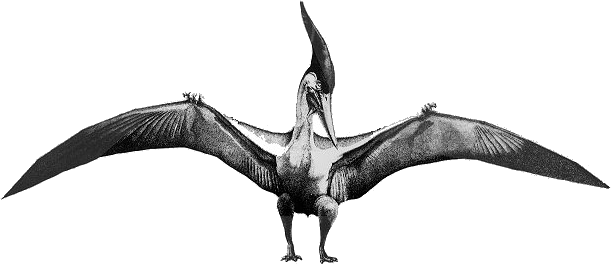

Although bones of Pteranodon were first discovered in the 1860s, it was not until after the turn of the century that we had a reasonably complete picture of the animal. Its bones are hollow and thin-walled; therefore, they were usually crushed flat. Also skeletons were generally incomplete. Like our model, it was necessary to incorporate bones from several specimens in order to reconstruct Pteranodon.
Pteranodon ingens Marsh is not the largest pterosaur. Thatís Quetzalcoatlus, with a 35- to 40-foot wingspan! It is not even the biggest known Pteranodon. That one has a wingspan of about 25 feet, and ours is closer to 22. But it is about the biggest based on reasonably complete material. It has been mounted banking into a left turn: the left wing is slightly contracted (you can see this well from above and below), the right wing is higher than the left, the head is looking a little to the left, and the body is pitched slightly forward in descent.
Why are the bones so large and yet so thin? It turns out that these bones donít need to withstand compressive forces (as the legs do), but they do have to withstand the tensile and torsional forces of flight. The ability to do that depends almost entirely on the diameter of the bone, not on the thickness. So the bones may appear to be thick, but they weighed next to nothing. The whole animal probably didnít tip the scales at more than 20 to 25 lbs. Thus Pteranodon is something of an optical illusion. Appearances are not always what they seem.
Pteranodon ingens is located on the first floor of the Valley Life Sciences Building in the circular stairwell. He is soaring above the T. rex on the ground floor. Stop by for a closer look. To learn more about pterosaurs, see the virtual pterosaur exhibit.
Directions and times for the Valley Life Sciences Building (VLSB).